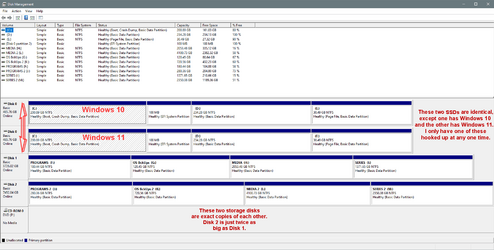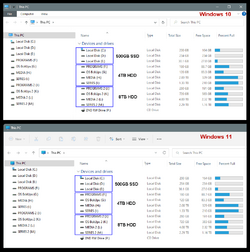yeah, i didn't say RAID 1 is only for servers. I just think it's best utilized there, when you cannot afford to have a box down because the OS drive won't boot. But yes, RAID 1 will protect you from a hard drive failure.....but that's all.
LOL. Every writeup you will find about RAID 1 says a downside is that you only get 1/2 of the capacity. If you run RAID 0 you get 100% of your capacity, thus 2 x 4TB drives gives you 8TB to store say videos. If you have a collection of videos and they are 7TB, they will git on your RAID 0. If you go RAID 1, you only get 50% of the capacity that you bought. So, 2 x 4TB is just 4TB. If you have 7TB of videos, they won't fit on your RAID 1 array. It's all semantics. You haven't exactly "lost it", but you cannot use it in a fashion that everybody would expect.
My biggest concern with a home environment and RAID 1 is extra complexity in the setup, making imaging and restoring images harder. The only real advantage is to protect you if 1 hard drive were to fail. It does nothing to save you from yourself, viruses, malware, ransomware, data corruption, overwriting an important file, etc. All of those things can be mitigated by making backups, and backups can also save your bacon if your hard drive fails.
RAID is not a backup. It should never be considered as such. It's only protection against a drive failure.
Yeah, and I didn't say you said that either. I also stressed that this is a matter of user preference and even went so far as to refer to it as a luxury. A little extra protection can't hurt but there are times when it can certainly come in handy.
Not every writeup about RAID 1 says that the downside is that the user only gets 1/2 of the capacity but I've certainly read the articles that suggest it and I think they are misleading. The user still has the same capacity but it is accessed differently. Two physical 8TB hard drives in RAID 1 still allow access to 16TB of capacity, but access to the second drive is indirect. Two equal sized glasses of water filled to 1/2 their capacity still = 1 full glass of water. The system reads 8TB X 2 as only 8TB because it was instructed to read it as a single drive and treat it as such. Physically, the user in this example still has 16TB capacity at their disposal and can easily reset the drives to make the system recognize this. Of course doing so will result in the loss the RAID array and I think that should be expected.
My 12 year old has had RAID 1 on her PC since she was 10. She has a shortcut to the array on her desktop called "Archives". She drags and drops folders to the array just as one would access any regular drive. She puts her drawings, music, videos, etc. on this drive. One day her Western Digital backup drive failed. It was nasty. Her PC kept on blue screening so I had to repair her Windows 8.1 by some other means. I did eventually discover what caused the BSOD. It certainly wasn't her Archives, but I recall her words to me as she smiled and said, "It's a good thing I kept all my important stuff in my archive folder". She lost nothing of consequence as she had kept all her "personal stuff" on a separate raided drive in duplicate. That grin on her face after she accessed the fresh shortcut she made on her desktop was priceless.
Not using RAID 1 will not protect you from viruses, malware, ransomware, bloatware, shareware, scareware, I don't care either, so the point is moot. There is software for those sorts of things. People over write files on non-raid just as easily as they do on RAID. Data can go corrupt regardless. This brings me to my final point: Backups fail. Backups fail often. In fact, a corrupt backup can completely destroy your data. Is RAID a replacement for backup? A: Not at all.
Having duplicate copies of personal data on a RAID 1 array is extra insurance against a failed backup. You can image your operating system, make restore points, and run your PC just as easily as you can without RAID if you simply use RAID strictly for storage. You don't need to put your OS on a RAID array as some folks do. On my work station I run five different RAID arrays. My operating system isn't on any of them.* As for failed backups I could tell you some stories but then I'd have to write a book.
Moral of the story: Never trust in backups alone. Never put all your eggs in one basket.
*correction* My secondary operating system is in RAID 0. It has been this way for years. My main OS isn't on a RAID array. Funny thing is, I'm typing this on a very old, never failed, Windows 7 Ultimate OS in RAID 0. (Supposedly one of the most volatile arrays going.) Perhaps I should boot back to my Win 11. I forgot I was still on Windows 7.

It runs soo smooth!
for RAID 0. Probably not something for the novice. Mirroring is simple, but you still have to configure your UEFI for RAID before you begin and if you didn't install your OS after configuring your "BIOS" for RAID there's a good chance you'll lose your boot strap. My advice is to do some research first, watch some videos, and then decide if you really need it. Most folks don't. It's really a matter of user preference.










